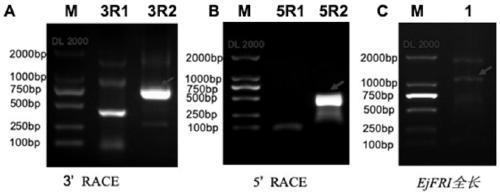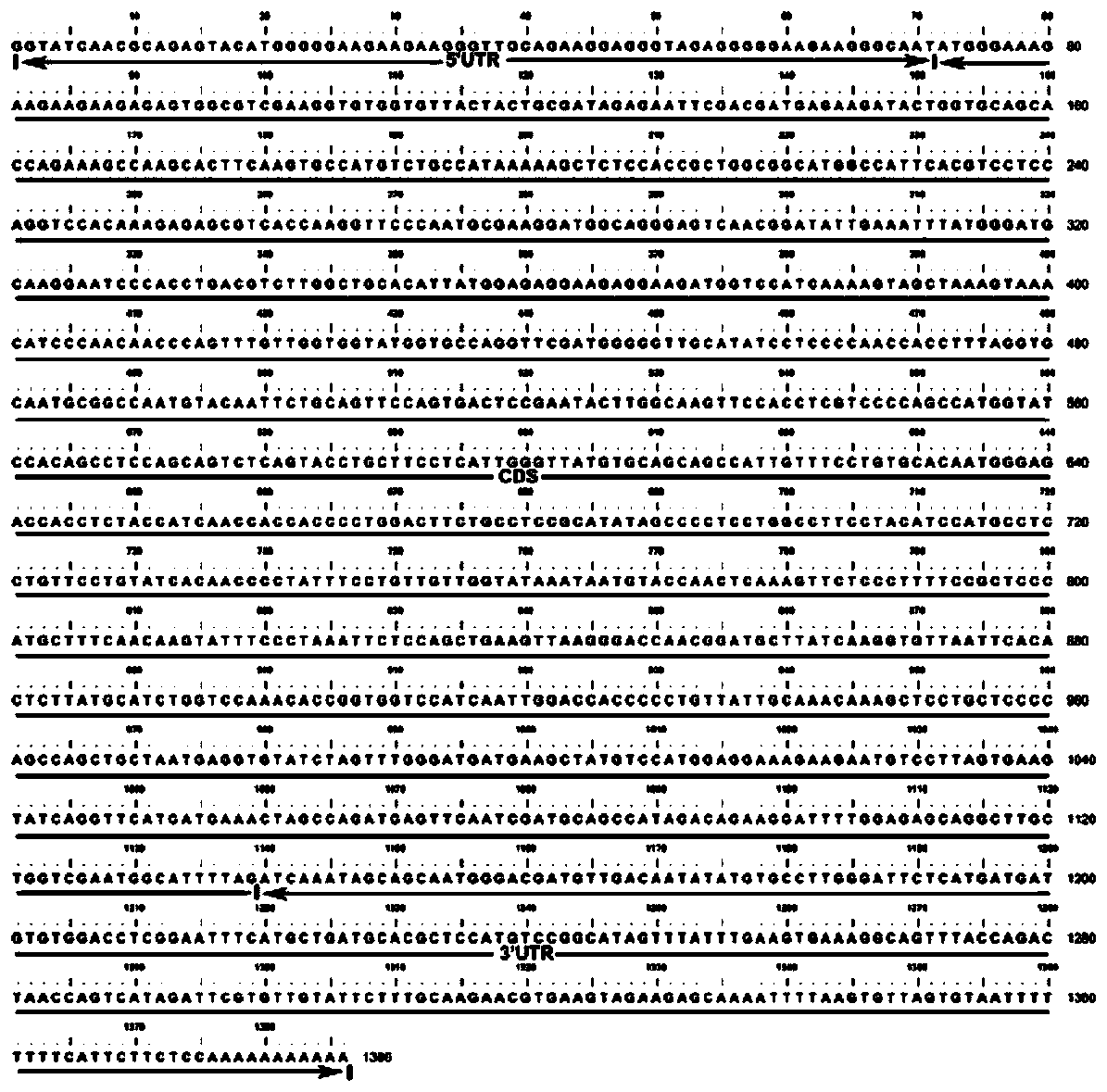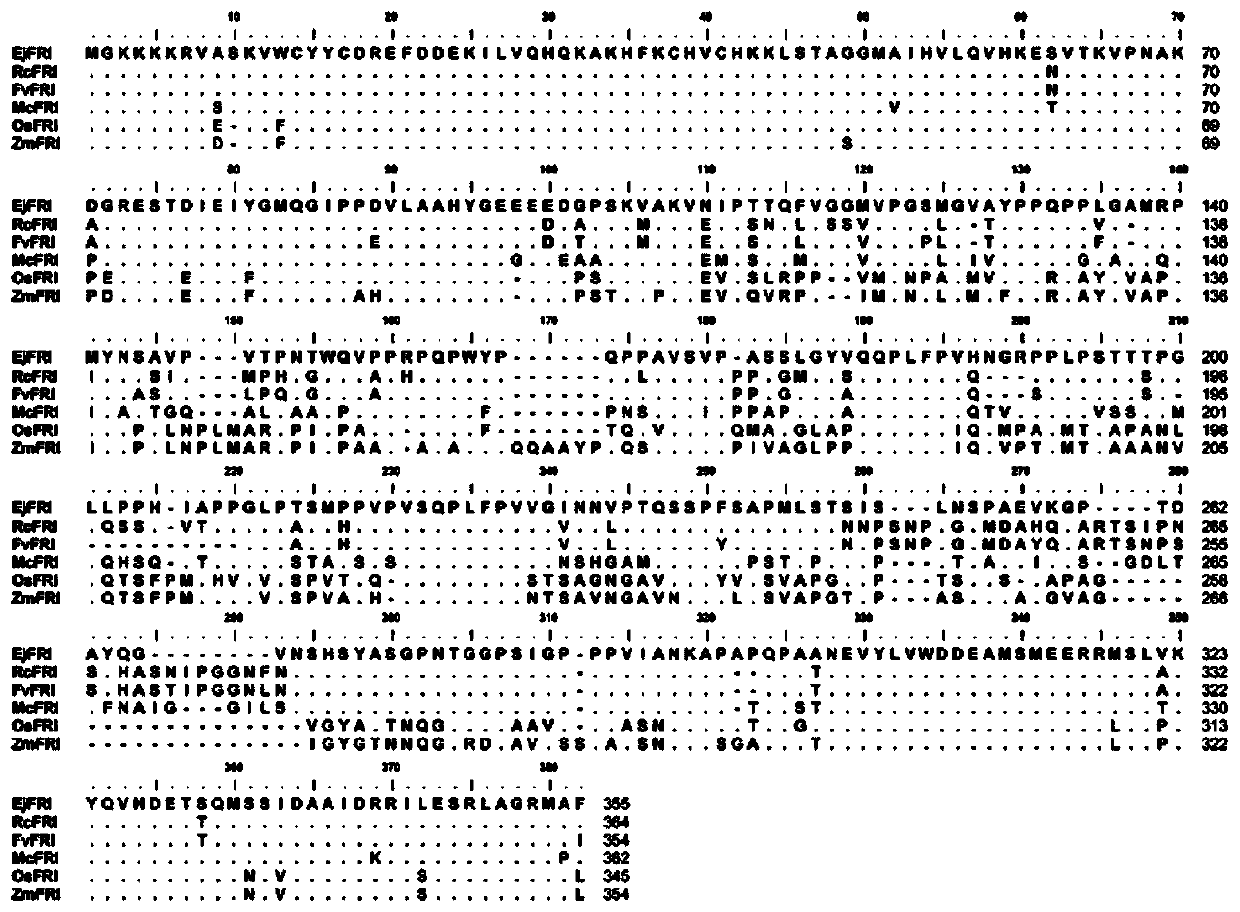EjFRI gene for delaying loquat flowering time and encoded protein and application thereof
A gene and loquat technology, which is applied to the loquat EjFRI protein and its encoding gene and application fields, can solve the problems of ungene sequence accuracy verification, functional research and reporting, etc., and achieves delayed flowering time, delayed result time, and good application prospects. Effect
- Summary
- Abstract
- Description
- Claims
- Application Information
AI Technical Summary
Problems solved by technology
Method used
Image
Examples
Embodiment 1
[0022] Cloning of embodiment 1 loquat EjFRI gene cDNA sequence
[0023] Extraction of Total RNA from Loquat Flower Buds
[0024] Fresh flower buds with a length of about 0.5 cm in the differentiation stage of loquat were collected, quickly sampled, put into cryopreservation tubes, put into liquid nitrogen for quick freezing for 2 hours, and then put into -80°C ultra-low temperature freezer for use. Extract total RNA from loquat flower buds using an RNA extraction kit: take out the collected flower buds from the -80°C ultra-low temperature freezer, put them into a pre-frozen mortar with 1 mL of RLT lysate and 100 μL of PLANTaid, at room temperature, Grind thoroughly; transfer the above grinding solution to a 1.5mL eppendorf centrifuge tube, centrifuge at 13000rpm for 10min, absorb 500μL supernatant, and transfer to a new 1.5mL centrifuge tube; add 250μL absolute alcohol to the supernatant, pipette to mix After uniformity, add to the adsorption column, and then put the adsorpti...
Embodiment 2
[0035] Example 2 The subcellular localization analysis of loquat EjFRI gene
[0036] Use the software Oligo7 to analyze the restriction site of the ORF sequence of the EjFRI gene, and design the restriction site primers at both ends, LEjFRI-BamHI: 5'- GGATCC ATGGGAAAGAAGAAGAAGAGAGT-3'; LEjFR-SalI: 5'- GTC GAC AAATGCCATTCGACCAGCAAGC-3'. Using the correctly sequenced pMD18-EjFRI plasmid as a template for amplification, the ORF sequence of the EjFRI gene containing BamHI and SalI restriction sites was obtained. The target gene and the transformed vector pCAMBIA1300 plasmid were respectively extracted, and double-digested with restriction endonucleases BamHI and SalI, and recovered after agarose gel electrophoresis. Use T 4 DNA ligase connects the double-digested target gene EjFRI and the modified pCAMBIA1300 vector, and transfers the recombinant vector into Escherichia coli competent cells, and then performs bacterial liquid PCR and double-digestion verification before sequ...
Embodiment 3
[0039] Real-time fluorescent quantitative PCR analysis of embodiment 3 loquat EjFRI gene
[0040] The total RNA of loquat stems, leaves, leaf buds, flower buds and flowers were extracted respectively, and after the trace amount of DNA in the total RNA was removed, it was reverse transcribed into cDNA. Based on loquat cDNA as a template, oligo 7.0 software was used to design real-time fluorescent quantitative PCR primers qEjFRIF:5'-GCAGCACCAGAAAGCCAAGCA-3' and qEjFRIR:5'-GTTGACTCCCTGCCATCCTTCG-3'. The loquat actin gene was used as an internal reference gene, and the primers were qRTEjactinF: 5'-AATGGAACTGGAATGGTCAAGGC-3' and qRTEjactinR: 5'-TGCCAGATCTTCTCCATGTCATCCCA-3', and its specificity was detected by PCR. Real-time fluorescence quantitative PCR experiments can be carried out, and each reaction is set up with 3 biological replicates. The PCR reaction program is: 94°C pre-denaturation for 5min; 94°C for 20s, 56°C for 20s, 72°C for 20s, 41 cycles, and then, collect the melt...
PUM
 Login to View More
Login to View More Abstract
Description
Claims
Application Information
 Login to View More
Login to View More - R&D
- Intellectual Property
- Life Sciences
- Materials
- Tech Scout
- Unparalleled Data Quality
- Higher Quality Content
- 60% Fewer Hallucinations
Browse by: Latest US Patents, China's latest patents, Technical Efficacy Thesaurus, Application Domain, Technology Topic, Popular Technical Reports.
© 2025 PatSnap. All rights reserved.Legal|Privacy policy|Modern Slavery Act Transparency Statement|Sitemap|About US| Contact US: help@patsnap.com



